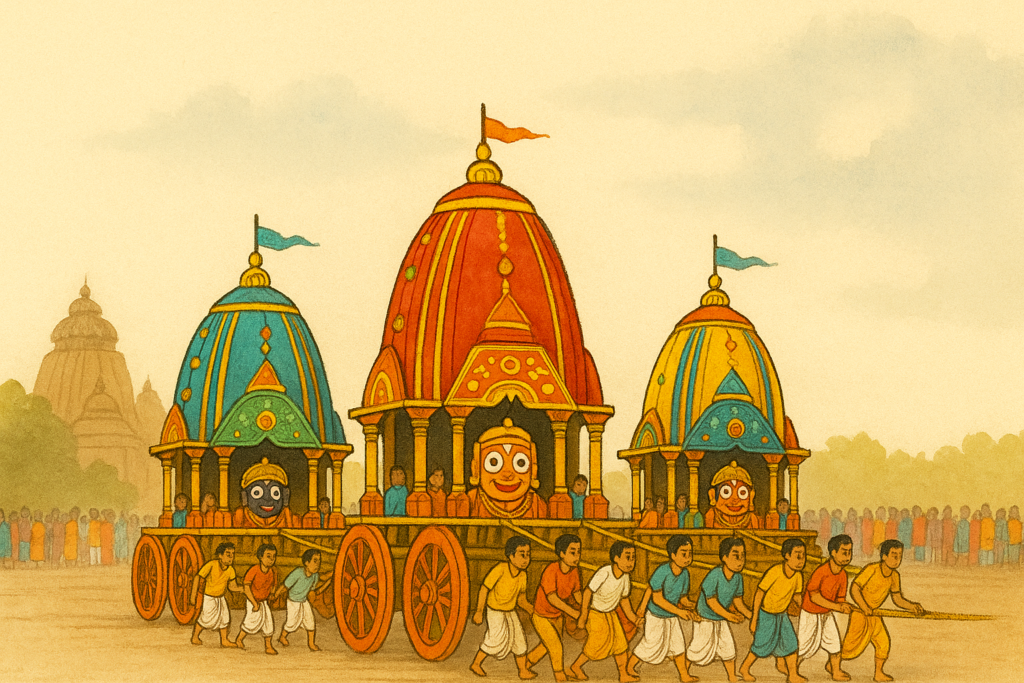
Rath Yatra, or Rathyatra, also known as the Chariot Festival, is one of the most celebrated and visually spectacular festivals in India. Centred around the deities Lord Jagannath, Lord Balabhadra, and Goddess Subhadra, this ancient tradition draws millions of devotees and tourists alike, especially in the coastal city of Puri, Odisha.
What is Rath Yatra?
Rath Yatra is a Hindu festival that involves a grand procession of deities on elaborately decorated chariots. It symbolizes Lord Jagannath’s annual visit to his aunt’s home at the Gundicha Temple, located approximately 3 kilometres from the Jagannath Temple in Puri.
The term “Rath” means chariot, and “Yatra” means journey—thus, it’s a Chariot Journey of the divine siblings.
When Did Rath Yatra Start?
The tradition of Rath Yatra is over 800 years old, dating back to the 12th century, around the same time King Anantavarman Chodaganga Deva of the Eastern Ganga Dynasty constructed the Jagannath Temple. However, references to similar festivals can be found in ancient scriptures, such as the Skanda Purana, suggesting even older origins.
When is Rath Yatra Celebrated?
Rath Yatra is celebrated annually in the Hindu month of Ashadha (June–July), on the Dwitiya (second day) of the bright fortnight (Shukla Paksha). In 2025, Rath Yatra falls on 27 June.
How is Rath Yatra Celebrated?
Key Rituals and Celebrations:
- Construction of Chariots
Months before the festival, skilled artisans began building three massive wooden chariots for Lord Jagannath, Balabhadra, and Subhadra from scratch.
- Pahandi Bije
The deities are ceremonially brought out of the sanctum sanctorum and placed onto their respective chariots in a rhythmic swaying procession called Pahandi.
- Pulling of the Chariots
Lakhs of devotees pull the chariots with ropes through the streets of Puri. This is believed to be an act of great spiritual merit.
- Stay at Gundicha Temple
The deities reside at the Gundicha Temple for nine days, where they are worshipped before returning to the main temple in a similar procession called the Bahuda Yatra.
- Return Journey (Ulta Rath)
The return journey marks the end of the festival, culminating in the ritual called Suna Besha, where the deities are adorned with gold ornaments.
Where is Rath Yatra Celebrated?
While Puri, Odisha, is the heart of the Rath Yatra, it is also celebrated in various parts of India and the world:
- Ahmedabad, Gujarat – The second-largest Rath Yatra in India, organized by the Jagannath Temple in Jamalpur.
- Kolkata, West Bengal – ISKCON organizes grand processions that attract thousands.
- Mumbai, Delhi, Hyderabad – Various ISKCON temples conduct Rath Yatra.
- Internationally, major cities such as New York, London, and Singapore also host Rath Yatras organized by ISKCON.
Significance of Rath Yatra
- Unity in Diversity: It brings people of all castes, creeds, and backgrounds together.
- Symbol of Devotion: Pulling the chariot is considered equivalent to receiving divine blessings.
- Spiritual Journey: Represents Lord Jagannath’s love for his devotees and his willingness to leave the temple to meet them.
FAQs About Rath Yatra
Q1. Who are the three deities in Rath Yatra?
A: Lord Jagannath (a form of Krishna), his elder brother Balabhadra, and sister Subhadra.
Q2. Why do the deities leave the temple?
A: They symbolically visit their aunt’s place at Gundicha Temple, reflecting humility and divine grace.
Q3. What are the names of the chariots?
- Lord Jagannath’s chariot: Nandighosha (45 feet high)
- Balabhadra’s chariot: Taladhwaja
- Subhadra’s chariot: Darpadalana
Q4. Can anyone pull the chariot?
A: Yes! Devotees believe that pulling the chariot grants liberation (moksha) and spiritual merit.
Q5. What happens after the Rath Yatra?
A: The return journey (Bahuda Yatra) concludes the festival. The deities are welcomed back with rituals and adorned in gold during Suna Besha.
Conclusion
Rath Yatra is more than a religious event; it’s a living tradition, a celebration of faith, unity, and the eternal bond between the divine and the devotee. Whether you’re a spiritual seeker, a cultural enthusiast, or a curious traveller, witnessing the Rath Yatra in Puri is truly a once-in-a-lifetime experience.
